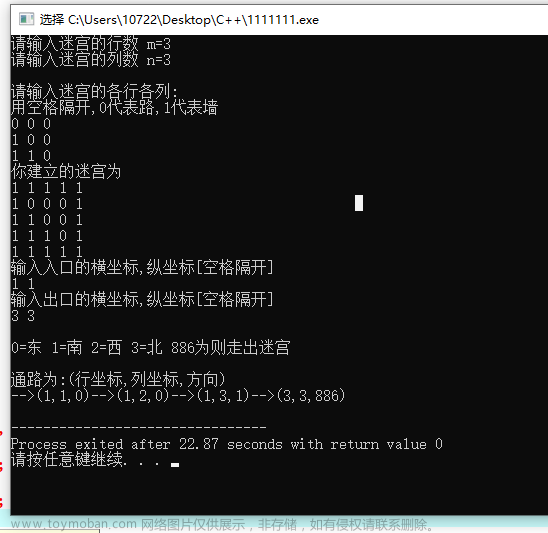前言:本章记录作者学习中,遇到的两个比较有趣的问题,一个简单和一个较复杂的迷宫问题。
一、迷宫问题的思路
让我们先来看简单的:迷宫问题
它的具体要求:
输入描述:
输入两个整数,分别表示二维数组的行数,列数。再输入相应的数组,其中的1表示墙壁,0表示可以走的路。数据保证有唯一解,不考虑有多解的情况,即迷宫只有一条通道。
如
5 5
0 1 0 0 0
0 1 1 1 0
0 0 0 0 0
0 1 1 1 0
0 0 0 1 0
要求输出 如:
(0,0)
(1,0)
(2,0)
(2,1)
(2,2)
(2,3)
(2,4)
(3,4)
(4,4)
这道题的重点有:只能上下左右走,不能斜着走;左上角为起点,右下角为终点;只有唯一解。
思路分析:
- 对于不支持变长数组的C版本来说,如果需要实现二维变长数组的话,就需要动态开辟二维数组。
- 每次需要对上下左右四个方向进行判断,才能到达下一个坐标,并且如果四个方向都不能走而且还没到达终点,那么就要往回走。
- 为了判断往回是否还有其它能走的方向,我们需要对走过的坐标进行标记,这样就不会出现走重复的路线。
- 在结束的时候,我们需要打印这条路径的每个坐标,那么我们就需要对我们走过的坐标进行储存,对到达不了终点的路上的坐标消除,所以似乎需要栈来帮我们储存这个坐标。
二、简单迷宫的代码实现
动态实现二维变长数组:
先创建一个二维指针,储存N个一维指针的地址,这些一维指针都分别指向一个开辟了M个数据的数组
#include<stdio.h>
void PrintMaze(int** maze, int N, int M)
{
for (int i = 0; i < N; i++)
{
for (int j = 0; j < M; j++)
{
printf("%d ", maze[i][j]);
}
printf("\n");
}
}
int main()
{
int N = 0, M = 0;
scanf("%d %d", &N, &M);
//动态开辟二维数组
int** maze = (int**)malloc(sizeof(int*) * N);
for (int i = 0; i < N; i++)
{
maze[i] = (int*)malloc(sizeof(int) * M);
}
for (int i = 0; i < N; i++)
{
for (int j = 0; j < M; j++)
{
scanf("%d", &maze[i][j]);
}
}
PrintMaze(maze, N, M);//测试是否能打印,看看有没有问题
for (int i = 0; i < N; i++)
{
free(maze[i]);
}
free(maze);
return 0;
}
四个方向判断的实现:
为了方便操作,我们建立一个结构体类型,方便定义坐标。
typedef struct position
{
int row;
int col;
}PT;
并且在测试页定义初始变量:
PT cur = { 0,0 };
- 从(0,0)坐标开始,假设先判断上下,再判断左右,如果能通过就移动坐标,并且进入下次判断,直到到达终点,或者不能移动,并且需要对每次到达的坐标进行标记,假设标记为2.
- 如果四个方向都不能走,并且没到达终点,那么将一直返回上一个位置,直到有其它方向能走。
- 如果到达终点,返回true,直到跳出所有递归。
//判断下一个坐标是否能通过
bool IsPass(int** maze, int N, int M, PT cur)
{
if (cur.col >= 0 && cur.col < M && cur.row >= 0 && cur.row < N
&& maze[cur.row][cur.col] == 0)
{
return true;
}
else
{
return false;
}
}
bool GetPath(int** maze, int N, int M, PT cur)
{
//到达终点
if (cur.row == N - 1 && cur.col == M - 1)
{
return true;
}
//上下左右判断
PT next;
maze[cur.row][cur.col] = 2;//标记
//上
next = cur;
next.row -= 1;
if (IsPass(maze, N, M, next))
{
//上方向可以通过就移动到上方向的坐标,并且继续判断四个方向是否可以移动
if (GetPath(maze, N, M, next))
{
//1.只有到达终点才会进入这次判断,并且一直返回true,直到退出所有递归。
//2.因为这题只有唯一解,所以一旦找到终点就可以直接返回。
return true;
}
}
//下
next = cur;
next.row += 1;
if (IsPass(maze, N, M, next))
{
if (GetPath(maze, N, M, next))
{
return true;
}
}
//左
next = cur;
next.col -= 1;
if (IsPass(maze, N, M, next))
{
if (GetPath(maze, N, M, next))
{
return true;
}
}
//右
next = cur;
next.col += 1;
if (IsPass(maze, N, M, next))
{
if (GetPath(maze, N, M, next))
{
return true;
}
}
//四个方向都不能走,就返回false,跳到上一个坐标判断它剩下的其它方向是否可以走
return false;
}
利用栈记录坐标的实现:
因为C语言没有自己的栈,所以我们还需要自己搭建一个栈。
栈的实现
- 每次判断坐标前,先将当前坐标存入栈中,如果四个方向都不能走的时候,再出栈。
- 当到达终点,返回完后,对栈中数据进行处理。
- 因为栈中数据打印后与题目要求的打印相反,所有需要再创建一个栈,将当前栈中的数据导入另一个栈中,从而实现相反的打印。
完整代码:
#include<stdio.h>;
#include<stdlib.h>;
#include<assert.h>;
#include<stdbool.h>;
typedef struct position
{
int row;
int col;
}PT;
typedef PT STDataType;
typedef struct stack {
STDataType* a;
int top;
int capacity;
}ST;
void StackInit(ST*ps);
void StackDestroy(ST* ps);
void StackPush(ST* ps, STDataType x);
void StackPop(ST* ps);
STDataType StackTop(ST* ps);
int StackSize(ST* ps);
bool StackEmpty(ST* ps);
//
void StackInit(ST* ps) {
ps->a = NULL;
ps->capacity = 0;
ps->top = 0;//或者-1
}
void StackPush(ST* ps, STDataType x) {
if (ps->capacity == ps->top) {
int newcapacity = ps->capacity == 0 ? 4 : ps->capacity * 2;
STDataType* tmp = (STDataType*)realloc(ps->a, sizeof(STDataType) * newcapacity);
if (tmp == NULL) {
printf("realloc fail\n");
exit(-1);
}
ps->a = tmp;
ps->capacity = newcapacity;
}
ps->a[ps->top++] = x;
}
void StackDestroy(ST* ps) {
assert(ps);
free(ps->a);
ps->a = NULL;
ps->capacity = ps->top = 0;
}
void StackPop(ST* ps) {
assert(ps);
/*assert(ps->top > 0);*/
assert(!StackEmpty(ps));
ps->top--;
}
STDataType StackTop(ST* ps) {
assert(ps);
assert(!StackEmpty(ps));
return ps->a[ps->top-1];
}
int StackSize(ST* ps) {
assert(ps);
return ps->top;
}
bool StackEmpty(ST* ps) {
return ps->top==0;
}
//
ST path;//可以创局部变量,这里方便一下
bool IsPass(int** maze, int N, int M, PT cur)
{
if (cur.col >= 0 && cur.col < M && cur.row >= 0 && cur.row < N
&& maze[cur.row][cur.col] == 0)
{
return true;
}
else
{
return false;
}
}
bool GetPath(int** maze, int N, int M, PT cur)
{
//走过的坐标先入栈
StackPush(&path, cur);
//到达终点
if (cur.row == N - 1 && cur.col == M - 1)
{
return true;
}
//上下左右判断
PT next;
maze[cur.row][cur.col] = 2;
//上
next = cur;
next.row -= 1;
if (IsPass(maze, N, M, next))
{
if (GetPath(maze, N, M, next))
{
return true;
}
}
//下
next = cur;
next.row += 1;
if (IsPass(maze, N, M, next))
{
if (GetPath(maze, N, M, next))
{
return true;
}
}
//左
next = cur;
next.col -= 1;
if (IsPass(maze, N, M, next))
{
if (GetPath(maze, N, M, next))
{
return true;
}
}
//右
next = cur;
next.col += 1;
if (IsPass(maze, N, M, next))
{
if (GetPath(maze, N, M, next))
{
return true;
}
}
//四个方向都不能走,就出栈返回
StackPop(&path);
return false;
}
void PrintPath(ST* ps)
{
ST rpath;//创建需要导数据的另一个栈
StackInit(&rpath);
while (!StackEmpty(ps))
{
StackPush(&rpath, StackTop(ps));
StackPop(ps);
}
while (!StackEmpty(&rpath))
{
PT cur = StackTop(&rpath);
printf("(%d,%d)\n", cur.row, cur.col);
StackPop(&rpath);
}
StackDestroy(&rpath);
}
int main()
{
int N = 0, M = 0;
scanf("%d %d", &N, &M);
PT cur = { 0,0 };
StackInit(&path);
//动态开辟二维数组
int** maze = (int**)malloc(sizeof(int*) * N);
for (int i = 0; i < N; i++)
{
maze[i] = (int*)malloc(sizeof(int) * M);
}
for (int i = 0; i < N; i++)
{
for (int j = 0; j < M; j++)
{
scanf("%d", &maze[i][j]);
}
}
if (GetPath(maze, N, M, cur))
{
PrintPath(&path);
}
StackDestroy(&path);
for (int i = 0; i < N; i++)
{
free(maze[i]);
}
free(maze);
return 0;
}
三、地下迷宫问题的思路
看看这个问题:地下迷宫

记录重点:
- 现在0代表障碍物,1代表通路,并且增加了体力值,左右移动减1,上移动减3,下移动不消耗,如果体力值为0还未到达出口,将无法逃离迷宫。
- (0,0)位置为起点,(0,m-1)位置为出口,并且现在要求最后打印的是最短路径。
- 体力值为0还未到达出口,结果需要打印:Can not escape!
- 坐标打印改变变成[0,0],
分析思路:
- 增加体力值P变量,并且当判断四个方向分别可以通过时,同时传入参数P,向上方向能通过传参数P-3,向左或者右方向能通过传P-1,向下传P;同时改变通路为1,出口为(0,m-1)
- 为了找到最短路径,直接通过建两个栈,一个记录当前路径的坐标,一个记录当前为止最短路径的坐标;利用递归列出所有可以走的路径,然后挑出最小的路径。(下面会重点介绍如何安全的转移栈以及如何用递归找到所有路径)
- 挑选的路径也要满足体力值条件;当所有的路径,体力都会耗尽且没有到达终点,记录最短路径坐标的栈为空,就可以通过这个情况打印Can not escape!。
四、地下迷宫的代码实现
先搭建一个基本的框架。
- 动态创建二维数组
- 获得路径
- 打印路径
创建体力值,并且改变通路条件、出口、打印和函数参数调用
//
ST path;//可以创局部变量,这里方便一下
bool IsPass(int** maze, int N, int M, PT cur)
{
if (cur.col >= 0 && cur.col < M && cur.row >= 0 && cur.row < N
&& maze[cur.row][cur.col] == 1) //通路条件为1
{
return true;
}
else
{
return false;
}
}
bool GetPath(int** maze, int N, int M, PT cur, int P)
{
//走过的坐标先入栈
StackPush(&path, cur);
//到达终点
if (cur.row == 0 && cur.col == M - 1) //终点为(0,m-1)
{
return true;
}
//上下左右判断
PT next;
maze[cur.row][cur.col] = 2;
//上
next = cur;
next.row -= 1;
if (IsPass(maze, N, M, next))
{
if (GetPath(maze, N, M, next, P-3))
{
return true;
}
}
//下
next = cur;
next.row += 1;
if (IsPass(maze, N, M, next))
{
if (GetPath(maze, N, M, next, P))
{
return true;
}
}
//左
next = cur;
next.col -= 1;
if (IsPass(maze, N, M, next))
{
if (GetPath(maze, N, M, next, P-1))
{
return true;
}
}
//右
next = cur;
next.col += 1;
if (IsPass(maze, N, M, next))
{
if (GetPath(maze, N, M, next, P-1))
{
return true;
}
}
//四个方向都不能走,就出栈返回
StackPop(&path);
return false;
}
void PrintPath(ST* ps)
{
ST rpath;
StackInit(&rpath);
while (!StackEmpty(ps))
{
StackPush(&rpath, StackTop(ps));
StackPop(ps);
}
while (StackSize(&rpath) > 1)
{
PT cur = StackTop(&rpath);
printf("[%d,%d],", cur.row, cur.col);
StackPop(&rpath);
}
//前面打印带"," 最后一个不带
PT cur = StackTop(&rpath);
printf("[%d,%d]\n", cur.row, cur.col);
StackPop(&rpath);
StackDestroy(&rpath);
}
int main()
{
int N = 0, M = 0, P = 0; //体力值P
scanf("%d %d %d", &N, &M, &P);
PT cur = { 0,0 };
StackInit(&path);
//动态开辟二维数组
int** maze = (int**)malloc(sizeof(int*) * N);
for (int i = 0; i < N; i++)
{
maze[i] = (int*)malloc(sizeof(int) * M);
}
for (int i = 0; i < N; i++)
{
for (int j = 0; j < M; j++)
{
scanf("%d", &maze[i][j]);
}
}
if (GetPath(maze, N, M, cur, P))
{
PrintPath(&path);
}
StackDestroy(&path);
for (int i = 0; i < N; i++)
{
free(maze[i]);
}
free(maze);
return 0;
}
找到所有的路径和记录的实现:
主要难的是这里的递归思想。
- 如果有通路,就移动到下一个坐标进行四个方向的判断,直到体力值用完到达终点或者没有到达终点。
- 到达终点之后,第一次到达终点保存这条路径,之后比较两条路径,选最短的路径;之后回到上一个坐标点
- 到达终点之后,当前坐标继续进行四个方向的判断,当四个方向都不能通过的时候,为了让下次能访问这个坐标,将这个坐标恢复为1,并且返回上一个坐标。
- 每个可以通过的坐标都将进行4个方向的判断,当所有可通过坐标判断完成,递归函数结束。
为什么要创建两个栈?
因为有一个栈里面的数据是会变的,所有需要深拷贝一个栈记录原来不变的数据。
void StackCopy(ST* path, ST* minpath)
{
minpath->a = (STDataType*)malloc(sizeof(STDataType*) * path->capacity);
memcpy(minpath->a, path->a, sizeof(STDataType) * path->top);
minpath->capacity = path->capacity;
minpath->top = path->top;
}
void GetPath(int** maze, int N, int M, PT cur, int P)
{
StackPush(&path, cur);
//到达终点
if (cur.row == 0 && cur.col == M - 1)
{
if (P >= 0 && StackEmpty(&minpath) || StackSize(&path) < StackSize(&minpath))
{
StackDestroy(&minpath);
StackCopy(&path, &minpath);
}
}
//上下左右判断
PT next;
maze[cur.row][cur.col] = 2;
//上
next = cur;
next.row -= 1;
if (IsPass(maze, N, M, next))
{
GetPath(maze, N, M, next, P - 3);
}
//下
next = cur;
next.row += 1;
if (IsPass(maze, N, M, next))
{
GetPath(maze, N, M, next, P);
}
//左
next = cur;
next.col -= 1;
if (IsPass(maze, N, M, next))
{
GetPath(maze, N, M, next, P - 1);
}
//右
next = cur;
next.col += 1;
if (IsPass(maze, N, M, next))
{
GetPath(maze, N, M, next, P - 1);
}
//恢复
maze[cur.row][cur.col] = 1;
StackPop(&path);
}
完整代码:文章来源:https://www.toymoban.com/news/detail-786314.html
#include<stdio.h>;
#include<stdlib.h>;
#include<assert.h>;
#include<stdbool.h>;
#include<string.h>;
typedef struct position
{
int row;
int col;
}PT;
typedef PT STDataType;
typedef struct stack {
STDataType* a;
int top;
int capacity;
}ST;
void StackInit(ST* ps);
void StackDestroy(ST* ps);
void StackPush(ST* ps, STDataType x);
void StackPop(ST* ps);
STDataType StackTop(ST* ps);
int StackSize(ST* ps);
bool StackEmpty(ST* ps);
void StackInit(ST* ps) {
ps->a = NULL;
ps->capacity = 0;
ps->top = 0;//或者-1
}
void StackPush(ST* ps, STDataType x) {
if (ps->capacity == ps->top) {
int newcapacity = ps->capacity == 0 ? 4 : ps->capacity * 2;
STDataType* tmp = (STDataType*)realloc(ps->a, sizeof(STDataType) * newcapacity);
if (tmp == NULL) {
printf("realloc fail\n");
exit(-1);
}
ps->a = tmp;
ps->capacity = newcapacity;
}
ps->a[ps->top++] = x;
}
void StackDestroy(ST* ps) {
assert(ps);
free(ps->a);
ps->a = NULL;
ps->capacity = ps->top = 0;
}
void StackPop(ST* ps)
{
assert(ps);
/*assert(ps->top > 0);*/
assert(!StackEmpty(ps));
ps->top--;
}
STDataType StackTop(ST* ps)
{
assert(ps);
assert(!StackEmpty(ps));
return ps->a[ps->top - 1];
}
int StackSize(ST* ps)
{
assert(ps);
return ps->top;
}
bool StackEmpty(ST* ps)
{
return ps->top == 0;
}
void StackCopy(ST* path, ST* minpath)
{
minpath->a = (STDataType*)malloc(sizeof(STDataType*) * path->capacity);
memcpy(minpath->a, path->a, sizeof(STDataType) * path->top);
minpath->capacity = path->capacity;
minpath->top = path->top;
}
ST path;
ST minpath;
//判断通路
bool IsPass(int** maze, int N, int M, PT cur)
{
if (cur.col >= 0 && cur.col < M && cur.row >= 0 && cur.row < N
&& maze[cur.row][cur.col] == 1)
{
return true;
}
else
{
return false;
}
}
//递归找到最小路径
void GetPath(int** maze, int N, int M, PT cur, int P)
{
StackPush(&path, cur);
//到达终点
if (cur.row == 0 && cur.col == M - 1)
{
if (P >= 0 && StackEmpty(&minpath) || StackSize(&path) < StackSize(&minpath))
{
StackDestroy(&minpath);
StackCopy(&path, &minpath);
}
}
//上下左右判断
PT next;
maze[cur.row][cur.col] = 2;
//上
next = cur;
next.row -= 1;
if (IsPass(maze, N, M, next))
{
GetPath(maze, N, M, next, P - 3);
}
//下
next = cur;
next.row += 1;
if (IsPass(maze, N, M, next))
{
GetPath(maze, N, M, next, P);
}
//左
next = cur;
next.col -= 1;
if (IsPass(maze, N, M, next))
{
GetPath(maze, N, M, next, P - 1);
}
//右
next = cur;
next.col += 1;
if (IsPass(maze, N, M, next))
{
GetPath(maze, N, M, next, P - 1);
}
maze[cur.row][cur.col] = 1;
StackPop(&path);
}
//打印坐标
void PrintPath(ST* ps)
{
ST rpath;
StackInit(&rpath);
while (!StackEmpty(ps))
{
StackPush(&rpath, StackTop(ps));
StackPop(ps);
}
while (StackSize(&rpath) > 1)
{
PT cur = StackTop(&rpath);
printf("[%d,%d],", cur.row, cur.col);
StackPop(&rpath);
}
PT cur = StackTop(&rpath);
printf("[%d,%d]\n", cur.row, cur.col);
StackPop(&rpath);
StackDestroy(&rpath);
}
int main()
{
int N = 0, M = 0, P = 0;
scanf("%d %d %d", &N, &M, &P);
PT cur = { 0,0 };
StackInit(&path);
StackInit(&minpath);
//动态开辟二维数组
int** maze = (int**)malloc(sizeof(int*) * N);
for (int i = 0; i < N; i++)
{
maze[i] = (int*)malloc(sizeof(int) * M);
}
for (int i = 0; i < N; i++)
{
for (int j = 0; j < M; j++)
{
scanf("%d", &maze[i][j]);
}
}
//获得最小路径
GetPath(maze, N, M, cur, P);
if (!StackEmpty(&minpath))
{
PrintPath(&minpath);
}
else
{
printf("Can not escape!");
}
StackDestroy(&path);
StackDestroy(&minpath);
for (int i = 0; i < N; i++)
{
free(maze[i]);
}
free(maze);
return 0;
}
总结:迷宫问题的难点主要是怎么找到路径,如何打印路径坐标。如果能解决这些问题,那么对递归的理解以及栈的应用有很大的提升。文章来源地址https://www.toymoban.com/news/detail-786314.html
到了这里,关于【C数据结构】迷宫问题的文章就介绍完了。如果您还想了解更多内容,请在右上角搜索TOY模板网以前的文章或继续浏览下面的相关文章,希望大家以后多多支持TOY模板网!















